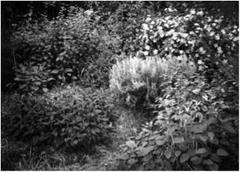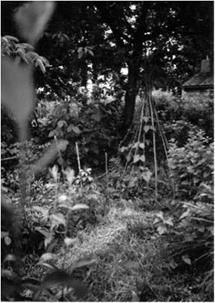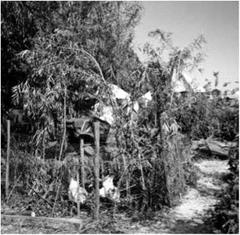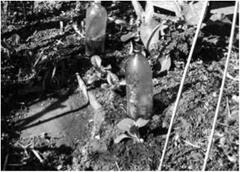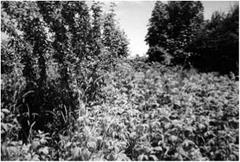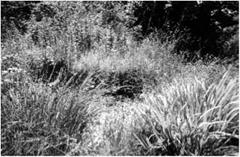Graeme Sherriff
Permaculture is all about solutions for sustainable living. It is an approach and methodology with a strong scientific basis and ethical justification, and it is already strongly represented in local food, Agenda 21 and Green political circles. This chapter looks at permaculture and its relevance to urban agriculture. It hinges on two questions: what is permaculture; and how can permaculture inform urban agriculture? Or, to put it another way, should the urban agriculturist also be a permaculturist?
PERMACULTURE
Permaculture is about producing food in an envi – ronmentally-sound way. It’s about people growing their own food on their own land and using it for themselves, their immediate family and possibly the local community. This is a very crude description of what Bill Mollison, permaculture’s founder, envisaged in the 1970s. The name itself derives from his vision of permanent agriculture (Mollinson, 1992).
A definition provided by a contemporary perma – culture designer brings us more up to date: ‘Permaculture has evolved into a system for the conscious design of sustainable productive systems which integrate housing, people, plants, energy and water with sustainable financial and political structures.’ (Hopkins, 2000, p.203)
Since its inception, permaculture has developed and diversified. The key words in Hopkins’ definition are ‘design’, ‘sustainable’ and ‘productive systems’. The key characteristic is that it sets out to maximise the beneficial relationships through the effective placement of elements. Bill Mollison devised a list of key principles by which this is effected, which are based on the example of nature. These are espoused in his 1988 ‘Designer’s Manual’ (Pepper, 1996):
1. Work with nature.
2. All nature plays a part in working land, e. g. worms aerate the soil.
3. Use minimum effort for maximum effect.
4. Increased yields, i. e. that it should be possible to increase the yield of a permaculture system through improving cultivation methods.
5. Outputs become inputs.
6. Each function should be supported by many elements.
7. Each element performs several functions.
8. Relative location, i. e. each element within the system should be located in the place most beneficial for the whole system.
Robert Hart’s forest garden in Shropshire is an often used exemplar, taking as it does the interconnectedness of the forest and redesigning it to create an ‘edible ecosystem’. Whitefield describes the elements, chosen carefully to maximise their interconnectedness: a canopy of fruit trees, a lower
|
Figure 22.1 |
Figure 22.1,22.2 and 22.3 Robert Hart’s permaculture garden, an ‘edible ecosystem’.
|
|
|
|
layer of dwarf fruit trees and nut bushes, a shrub layer of soft fruit, a layer of perennial herbs and vegetables at ground level, plus root vegetables and climbers (Whitefield, 1997).
As Whitefield observes, each layer comes into leaf at different times of the year – the herb layer in early spring, followed by the shrubs, and lastly the trees – so that, through careful selection and placement of the elements, the greatest possible use is made of the available natural resources. The same can be said of the soil resource, since the plants’ roots feed at different depths and each has a slightly different nutrient requirement. The cyclic nature of
the ecosystem (principle 6, above) is also reflected, with some plants needing specific nutrients for growth, and some returning those same nutrients to the soil (principle 5, above). The system is also relatively self-maintaining, as it uses perennial plants (principle 3, above).
Another often cited exemplar is the permaculture chicken. Whilst there may be some animal rights issues here, it is worth noting that permaculture animals are well looked after and (by definition) allowed to live out their natural desires where at all possible – certainly to a much greater degree than the conventional barn or battery methods of ‘husbandry’. In the
Figure 22.4 Permaculture chickens.
case studies I have researched, chickens and hens featured prominently. They could lay eggs for food use; their droppings could be used as fertiliser (principle 5, above); and they could be useful for controlling pests – they have been referred to as a ‘free range slug patrol’ (Sherriff, 1999). If a chicken house is connected to the side of a greenhouse then, as Whitefield (1997) enthuses: ‘the greenhouse is kept warm by the heat of the chickens; the chickens are kept warm in the winter by the sun coming through to the greenhouse; and the carbon dioxide exhaled by the chickens fuels plant growth in the greenhouse.’ – an excellent example of principles 5, 7 and 8, above.
So permaculture is distinguished partly by its use of nature as a model. Another characteristic is its ethical rootedness in sustainability. Robert Hart saw his gardening in the context of a sustainable vegan lifestyle,
|
Figure 22.4 |
feeding himself almost entirely from the forest garden and some other vegetable growing.
Whitefield (1997) describes the three ethical foundations of permaculture as: earth care, that we must look after the earth in order to look after ourselves; people care, that sustainability should not be achieved at the cost of our freedom and our quality of life; and fair shares, which is about recognising the limits of the earth. These are clearly very similar to the definition of sustainability espoused at the 1980 Rio Conference, that development should ‘meet the needs of the present, without compromising the ability of future generations to meet their own needs.’
Now we have arrived at a much more sophisticated definition:
‘permaculture is essentially an approach to designing whole systems, through the maximisation of the interconnectedness of elements, which has an ethical foundation in sustainability and a scientific basis in ecology.’
One thing to note is that permaculture is different from organic agriculture. By organic agriculture I refer to produce such as that certified under European Union standards and policed by organisations such as the Soil Association. This is basically agriculture without pesticides and fertilisers, without genetically modified crops, and with compassionate animal husbandry.
Permaculture will often look like organics, and the end result of a permaculture design may qualify for organic certification, but there a number of important differences. Organics is a production method: per – maculture is an approach to design and production.
Permaculture places more emphasis on cycling energy and resources locally; it places greater emphasis on the maximisation of interconnectedness; it is creative rather than regulatory; it
Figure 22.5 Recycling plastic bottles as cold frames. Figure 22.6 A typical small cold frame.
emphasises the use of perennials; self-regulatory systems are encouraged; and community trading structures take a clear priority over global trading. The latter is particularly striking. Whilst organisations such as the Soil Association should be congratulated for campaigning for more farmers’ markets and other local trading initiatives, you can still buy cabbages classed as organic that have been flown hundreds of miles for each of the processing, distribution and sale stages. This is in marked contrast to, for example, Hardy’s Field in Lincolnshire, which has sold carrots through a Local Exchange Trading Scheme (Sherriff, 1999). The ecological bill of the global food system has to take account of the transport networks needed to facilitate the increasing transit of food and food – related products as well as the significant greenhouse gas emissions from the transport itself. Fruit and vegetables now form the largest category of air freight by weight (Friends of the Earth, 2001), and much of this could be grown more locally.
Having described permaculture, how can it inform urban agriculture? Using our definition of permaculture, we can make this question more precise: why should a group or person involved in the growing of food in urban areas equip themselves with a methodology that involves the conscious design of systems based on the principles espoused by Mollison?
My first observation from my research, is that this approach has a track record of producing a large amount and variety of food from a small area. If a city is trying to move towards self-sufficiency, monocultural cropping becomes less and less relevant. Permaculture provides an approach to making our plots more and more diverse. One of the case studies for my research, a London household, reported that it was able to get basic vegetables and greens all year round and potatoes from July until December, all from their permaculture garden. Additionally, they
|
Figure 22.5 |
|
Figure 22.6 |
made summer fruits into preserves for use during the winter (Sherriff, 1999). Robert Hart’s example described above is another case of the significant way that permaculture can contribute towards self-sufficiency.
Where self-sufficiency is not the aim, permacultural trade systems extend the scope of the project from the individual to the community. The Local Exchange Trading Scheme (LETS) does for the community, what the permaculture garden does for plants: it maximises the interconnectedness between disparate elements, in this case, the needs and abilities of people in a community. Some members offer skills or products that others require, and they in turn offer another skill or product.
Vegetable box schemes are another way to distribute produce. Customers receive a box of mixed vegetables and fruit, with contents depending on the season, so the output of a permaculture plot or garden is perfectly suited. Farmers’ markets are ideal for trading permaculture produce: gone is the need, experienced when dealing with supermarkets, to grow a certain amount of a certain crop. One of the beauties of the simplicity of permacul – ture is that when its principles are applied to food production and to trade, the two activities become symbiotic: the diversity of permaculture food suits local schemes, and the financial security of the trading methods enables a greater variety of crops to be grown and creative risks to be taken.
Permaculture food growing is never seen in isolation. Becon Tree Organic Growers, for example, develop the local economy through LETS, work with a local university, and with colleges and conservation groups (Sherriff, 1999). They are able to fulfill the criteria of Local Agenda 21 through: reusing and recycling resources, saving energy, cultivating local land, monitoring the local environment, green building and planning, community development and education, and developing the local economy.
Permaculture, by definition, seeks where possible to utilise resources frugally. This is important in urban agriculture for two reasons: it enhances its sustainability; and it makes it inexpensive to practice. The latter is particularly important where urban agriculture is proposed as a way to regenerated deprived areas. It is common for resources to be recycled. At Naturewise in London, old vehicle tyres were used to form a ‘tyre garden’ and in another London example old glass bottles were ingeniously used as edging between the lawn and the borders both to stop weeds spreading and to use as miniature greenhouses in which to germinate seeds. At Beacon Tree Organic Growers:
‘. . . the pathways are made from heavy-duty rubber conveyor belts from a local gravel pit that are wide and strong enough to take an electric wheelchair and are covered with cockleshells form Leigh-on-Sea.’ (Warwick, 2001)
From butts to collect rainwater, to composting toilets that turn human excrement into usable fertiliser, the efficient use and reuse of resources is central to permaculture’s scientific and ethical foundations.
Another important aspect of permaculture is its avoidance of artificial fertilisers and pesticides, preferring instead to maintain soil health through a number of holistic techniques including polycultural planting and green mulching, and to deter pests through biodiverse planting and the encouragement of predators to frequent the ecosystem. Legumes, such as clover, can provide a crop with nitrogen, for example, and a biodiverse garden confuses pests and is therefore less vulnerable than a monoculture.
Overuse of artificial chemicals in farming is a significant environmental problem. The cost of removing agricultural pesticide residues from drinking water has been estimated at £119.60 million a year, and nitrous oxide from fertiliser use is a contributor to air pollution (Friends of the Earth, 2001). When thinking on the local and urban scale, water and air pollution becomes a more immediate threat to both producer and consumer than it does where food is produced and traded globally.
Figure 22.7 The edge of a forest garden.
Figure 22.8 Grasses: permaculture and diversity.
|
|
||
There is a growing body of evidence in support of concerns about artificial chemical use on health grounds. 45 pesticides, for example, are known or suspected hormone disruptors, potentially affecting the reproduction of both humans and wildlife. A recent study in Denmark found that women with higher than average levels of pesticides, such as dieldrin, in their bloodstream have double the risk of breast cancer (Sustain, 2001).
Conversely, produce grown without pesticides and fertilisers and in an organic regime are higher in nutritional value than those grown conventionally, due largely to the health of the soil. An American study found significantly higher levels of minerals in the former. There was reportedly 63 per cent more calcium, 73 per cent more iron, 125 per cent more potassium and 60 per cent more zinc (Sustain, 2001). Permaculturally produced food can be assumed to have similarly high standards since its attitudes to chemical use and the maintenance of soil health are comparable. It follows that any urban agriculture seeking to supply communities with a healthy alternative to the conventional would do
well to follow the chemical-free and soil building principles of organic agriculture. As discussed above, permaculture provides an approach to creatively apply these principles at the local level.
Permaculture, then, is valuable as an approach to urban food growing and provides a useful methodology for food growing and local trading. This chapter has been able to give only a very brief description of permaculture. The references list contains many excellent sources of further information.

